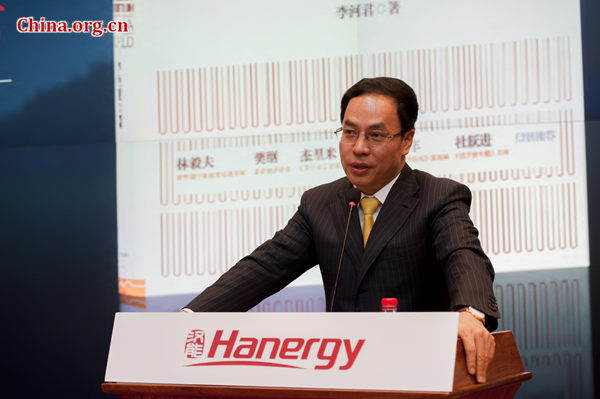Hanergy Believes In Future of Thin-Film Technology

China's leading photovoltaic (PV) producer Hanergy has reiterated that thin-film technology, as opposed to crystalline silicon cells, is the future of solar energy application.
Li Hejun, the company's chairman, said most clean energy peers in China are lingering in the polysilicon department because thin-film demands both core technology and durable financial ability.
Li made the remark at the launch of his book "New Energy Revolution -- the Power to change China and the World" on Wednesday in Beijing, clarifying a misconception shared by his fellow solar energy professionals who claim thin-film is not a mature technology, but, at best, something too good to be true.
"Though controversy still exists regarding the comparison between thin-film and polysilicon technologies, we trade insiders have no disagreement in regarding thin-film as the future of PV, in addition to being a trend already," said Li.
Thin-film advocator Hanergy seems to be an isolated case in China, amid fierce competition from polysilicon rivals who still enjoy a dominant market share of 90 percent based on crystalline silicon cell's reliable conversion rate of 15 percent.
Yet this very same fact has also repeatedly put China's crystalline silicon PV cell producers at odds with each other or, at intervals, under anti-dumping probes from the European Union and the United States.
"Hanergy has remained harmless in all of the past trade wars between China and the West, as those anti-dumping and anti-subsidy probes all targeted crystalline silicon products; our thin-film panels were not affected," Li said as he explained how his peers' pains were actually opportunities to expand the market share at home. He added thin-film's theoretical conversion rate would eventually reach 30 percent.
In his book, Li notes how crystalline silicon technology started to phase out in developed countries some five years ago. Recognizing the trend, Hanergy chose to focus on thin-film panels three years ago, when the company began to involve itself in the PV sector. "Crystalline silicon still represents high profit, but that does not necessarily translate into a bright future," said Li.
One anonymous trade insider has noted how crystalline silicon cells are more suitable in concentrated solar power generation due to lower costs; whereas thin-film panels, which are lighter and more flexible, have a future in what is called "building-integrated PV (BIPV)" power generation.
Such a solution enables individual houses to fully power themselves, independent of the national grid. In this scenario, each house will become its very own solar power plant.
"Besides a cut in electricity bills, BIPV will facilitate houses to power themselves in remote places the national grid does not yet reach," this person said.
Earlier, Hanergy and home furnishing expert IKEA signed a deal to put Hanergy's thin-film PV panels onto the rooftops of IKEA stores across China, as well as those of the Swedish company's selected suppliers.
For instance, at IKEA's Beijing Siyuanqiao branch, its rooftop installations carry an installed capacity of 416.24 KW, generating about 452,000 kWh every year, according to Hanergy. This translates into an annual reduction of carbon dioxide emissions by some 426 tons -- and a dramatic cut in IKEA's power bill.
In his book, Li also stated solar energy, among other clean energies, forms a solution to China's worsening air quality, especially that in major cities such as Beijing.
About Hanergy
Hanergy Holding Group Ltd. is China's largest private clean-energy power generation company, as well as the world's largest thin-film solar company.Established in 1994, the Company is headquartered in Beijing and has more than 8,000 employees. It has branches in several provinces in China as well as in North America, Europe, Asia-Pacific and other regions. Its businesses cover hydropower, wind power, and photovoltaic power generation. Since its establishment, Hanergy has been committed to "Clean Energy for a Better World? At present, its total installed capacity of hydropower project exceeds 6GW, and its total installed capacity of wind power projects is 131MW. In the field of solar energy, Hanergy has invested in the construction of thin-film solar industry R&D; and manufacturing bases in Sichuan, Guangdong, Hainan, Zhejiang, Shandong, Jiangsu and other places, with a total production capacity of 3GW. Through global technical integration and independent innovation, Hanergy�s thin-film photovoltaic technology has reached international advanced levels, with the conversion efficiency of its copper indium gallium selenide (CIGS) modules reaching 15.5%.Hanergy has entered into solar-power plant construction agreements that total a capacity of about 10GW. These projects are located in Xinjiang, Qinghai, Ningxia, Jiangsu, Hainan, Shandong, Hebei and other provinces as well as in European countries. Hanergy engages in the integration of the entire photovoltaic industry chain, covering R&D;, high-end equipment manufacturing, PV module production and construction of photovoltaic power plants. For more information, please visit Hanergy
Return to News.
